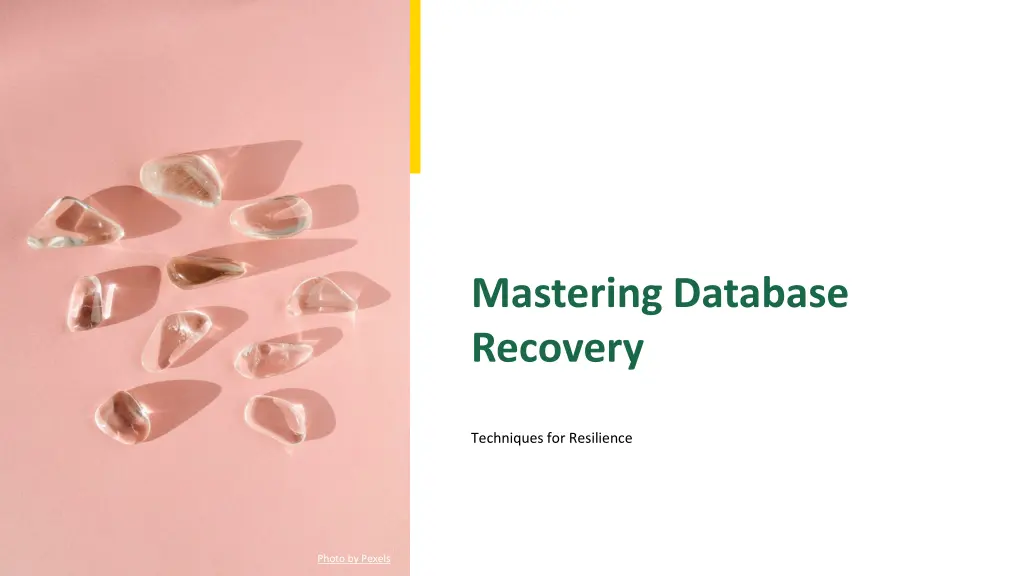
Effective Database Recovery Techniques for Resilience
Ensure data integrity and operational continuity with a comprehensive guide on database recovery techniques. Learn the importance of recovery, types of failures, and strategies for seamless restoration in times of crisis.
Download Presentation

Please find below an Image/Link to download the presentation.
The content on the website is provided AS IS for your information and personal use only. It may not be sold, licensed, or shared on other websites without obtaining consent from the author. If you encounter any issues during the download, it is possible that the publisher has removed the file from their server.
You are allowed to download the files provided on this website for personal or commercial use, subject to the condition that they are used lawfully. All files are the property of their respective owners.
The content on the website is provided AS IS for your information and personal use only. It may not be sold, licensed, or shared on other websites without obtaining consent from the author.
E N D
Presentation Transcript
Mastering Database Recovery Techniques for Resilience Photo by Pexels
01 Why Database Recovery Matters Table of Contents 02 Types of Database Failures 03 Exploring Recovery Techniques 04 Full Backup Strategies 05 Incremental Backups 06 Transaction Logging 07 Point-in-Time Recovery 08 Automated Recovery Solutions 09 Regular Testing and Updates 10 The Future of Database Recovery 11 Thank You!
1 Why Database Recovery Matters Importance Unveiled Every database could face unexpected failures or errors at any moment, causing potential data loss. Understanding the significance of recovery can help save crucial business informationand maintain trust with users. With effective recovery strategies, organizations can ensure data integrity and minimize downtime during crises. The importance of database recovery cannot be overstated as it secures the very foundationof data management. Photo by Pexels
2 Types of Database Failures Understanding Risks Database failures can range from hardware malfunctions to software bugs or even human errors affecting data consistency. Every potential failure type demands a tailored approach to recovery to ensure swift restoration of service. Identifying failure types helps in preparing robust strategies that enhance recovery processes. A comprehensive understanding of failure categories enables effective risk management and mitigation strategies. Photo by Pexels
3 Exploring Recovery Techniques Pathways to Restore Recovery techniques vary widely, including full backups, incremental backups, transaction logs, and point-in-time recovery. Each technique serves unique purposes and can be combined for a more resilient approach to data management. Selecting the right technique is critical, depending on database architecture and specific business needs. Effective recovery techniques pave the way to seamless database restoration and operational continuity. Photo by Pexels
4 Full Backup Strategies Complete Safety Net Full backups encompass the entire database, capturing a complete snapshot at a specific point in time. While they provide complete data recovery, they require more storage and time compared to other methods. Regularly scheduling full backups ensures a safety net against catastrophic data loss events. A well-planned full backup strategy is essential for organizations that prioritizedata security. Photo by Pexels
5 Incremental Backups Stepwise Recovery Incremental backups capture only the changes made since the last full or incremental backup, saving both time and storage. This technique allows organizations to restore to the most recent state without consuming excessive resources. Incremental backups are vital for dynamic databases that frequentlychange and evolve over time. A combination of full and incremental backups ensures a balanced recovery strategy for minimal data loss. Photo by Pexels
6 Transaction Logging Recording Every Action Transaction logs track all modifications to the database, allowing point-in-time recovery to exact changes. In the event of a failure, transaction logs enable recovery to a specific moment, minimizing data loss. Implementing transaction logging effectively requires careful planning to manage log file sizes and performance. Transaction logging serves as an active recovery measure, enhancing data integrityand availability. Photo by Pexels
7 Point-in-Time Recovery Restore with Precision Point-in-time recovery allows organizations to restore a database to a precise moment, counteractingspecific errors. By effectively utilizing transaction logs, businesses can recover from data corruptionor accidental deletions. This technique requires meticulous logging and monitoring of transactions to be fully effective. Point-in-time recovery minimizes the impact of data losses and enhances overall database reliability. Photo by Pexels
8 Automated Recovery Solutions Efficiency at Its Best Automation in recovery techniques enhances efficiency and reduces human error during the restoration process. By setting automated backups and recovery protocols, organizations can ensure continuous data protection. Automated systems can quickly adapt to changes and ensure recovery strategies remain effective. Embracing automation in database recovery heralds a new era of resilience and reliability for businesses. Photo by Pexels
9 Regular Testing and Updates Staying Prepared Just implementing recovery techniques isn't enough; regular testing of these strategies is crucial for assurance. Testing recovery plans ensures they work as intended, helping identify potential pitfalls before they occur. Teaching staff on recovery processes fosters a culture of preparedness within the organization. Regular updates to recovery techniques keep systems in sync with technological advancements and evolving business needs. Photo by Pexels
10 The Future of Database Recovery Innovations Ahead As technology evolves, so do the methods of database recovery, with cloud solutions becoming increasingly popular. Future advancements may include AI-driven recovery systems that automate and enhance recovery processes even further. Keeping an eye on emerging trends ensures organizations remain prepared for the unexpected in their data management. The future of database recovery holds promise, emphasizing resilience and continuous improvement in techniques. Photo by Pexels
11 Thank You! Stay Resilient We appreciate your attention and hope this presentation inspires you to prioritizedatabase recovery strategies. Embracing effective recovery techniques will lead to better data management and organizational resilience in challenging times. Let's ensure our databases are always one step ahead of potential failures with proactive recovery approaches. Thank you for being part of this journey towards data security and reliability! Photo by Pexels
